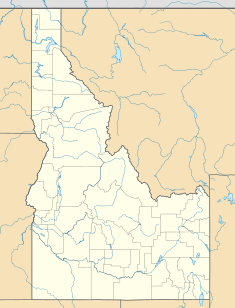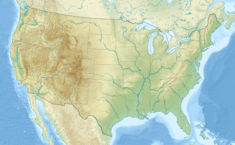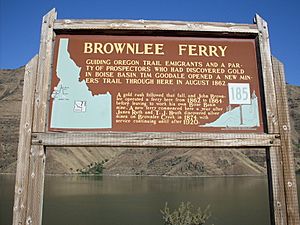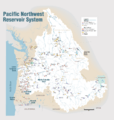Brownlee Dam facts for kids
Quick facts for kids Brownlee Dam |
|
|---|---|

View from northeast
|
|
|
Location in Idaho##Location in the United States
|
|
| Official name | Brownlee Dam |
| Country | United States |
| Location | Hells Canyon, Baker Co., Oregon / Washington Co., Idaho |
| Coordinates | 44°50′10″N 116°54′00″W / 44.836°N 116.9°W |
| Construction began | 1955 |
| Opening date | May 9, 1958 |
| Operator(s) | Idaho Power Company |
| Dam and spillways | |
| Impounds | Snake River |
| Height | 420 feet (128 m) |
| Reservoir | |
| Creates | Brownlee Reservoir |
| Total capacity | 1,426,700 acre-feet (1.7598 km3) |
| Catchment area | 72,590 square miles (188,000 km2) |
| Surface area | 15,000 acres (61 km2) |
| Normal elevation | 2,070 feet (630 m) |
| Power station | |
| Installed capacity | 585.4 MW |
| Annual generation | 2,406.8 GWh |
The Brownlee Dam is a large dam in the western United States. It is built on the Snake River, right where the states of Idaho and Oregon meet. This dam is a special type called a hydroelectric earth fill embankment dam. This means it is made mostly of packed dirt and rocks, and it uses the power of water to create electricity.
The dam is located in a deep canyon called Hells Canyon. It holds back the Snake River, forming a long lake known as the Brownlee Reservoir. This reservoir stretches for about 58-mile-long (93 km).
Contents
About Brownlee Dam and Its Purpose
The Brownlee Dam is part of a bigger project called the Hells Canyon Project. This project includes two other dams: Hells Canyon Dam and Oxbow Dam. All three dams were built and are run by the Idaho Power Company.
The Brownlee Dam was the first of these three dams to be built. Construction started in 1955. The company that built it was Morrison-Knudsen from Boise. The dam began holding back water on May 9, 1958. When the reservoir filled up, it covered a small town called Robinette, Oregon.
How Brownlee Dam Makes Electricity
The dam has a special building called a powerhouse. Inside, there are five large machines that create electricity. Together, these machines can produce 585.4 megawatts of power. This power is then sent out to homes and businesses.
Fish and the Dam
The three dams in the Hells Canyon Project do not have special ways for fish to pass through them. This means that fish like salmon, which swim upstream to lay their eggs, cannot get past the dams. This blocks their journey on a long part of the Snake River.
Naturally, Shoshone Falls further upstream also stops fish from going higher up the river. So, the dams block fish from an area between Hells Canyon Dam and Shoshone Falls.
Images for kids






